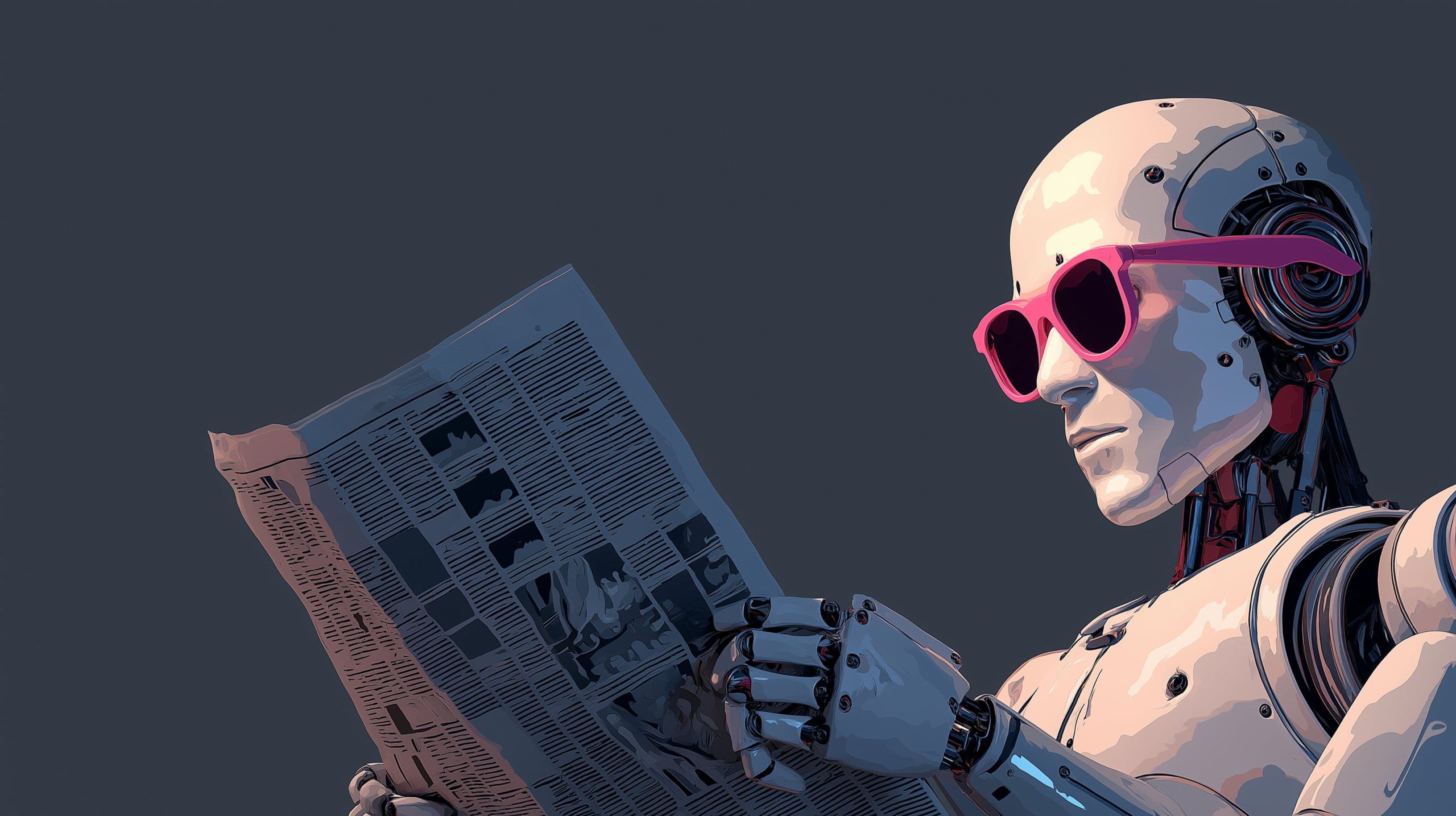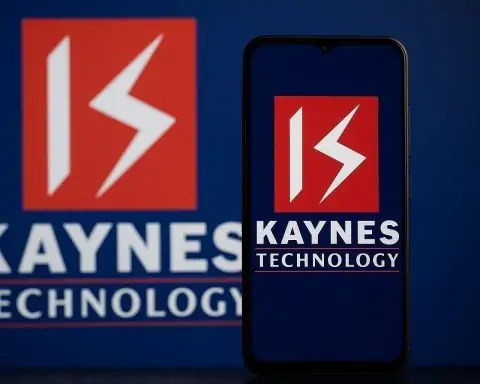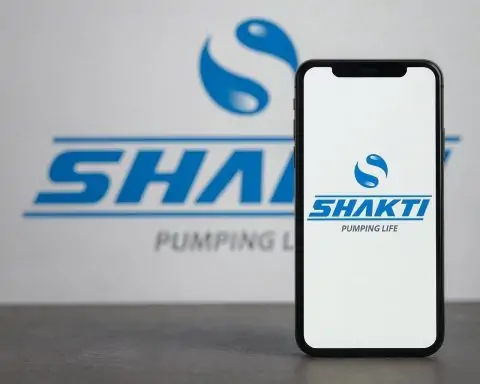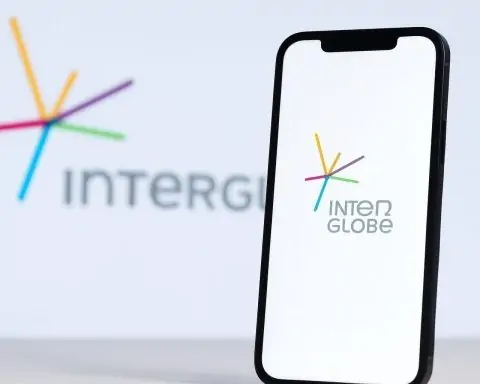- Micron Technology raised its current-quarter revenue outlook to $11.2 billion from $10.7 billion, and its stock jumped about 3%.
- Nvidia and AMD won export licenses to resume selling advanced AI chips to China with a 15% revenue-share tariff.
- Intel rose about 5% on Aug 11, 2025 after White House diplomacy aimed at easing U.S.–China chip tensions.
- Wedbush Securities reaffirmed Microsoft and Alphabet as AI front-runners with durable moats and maintained outperform ratings.
- SoundHound AI surged 43% over Aug 8–11 after posting record Q2 revenue of $42.7 million (up 217% year over year) and lifting full-year guidance to $160–$178 million, while GAAP net loss widened to $74.7 million due to one-time charges.
- C3.ai fell about 25% on Aug 11 after pre-announcing July-quarter revenue of $70.2–$70.4 million, well below last year’s $87 million and prior guidance of $100–$109 million.
- BigBear.ai fell about 20% after-hours on Aug 11 after reporting a Q2 loss and cutting its 2025 guidance, with revenue down 18% year over year.
- Salesforce announced on Aug 11 that it would acquire Waii, an AI startup for natural-language data analysis, to be integrated with Tableau and Agentforce, while its stock fell 3.2%.
- Meta Platforms was reportedly near a deal to acquire WaveForms, an emotional AI voice startup, after its July purchase of PlayAI.
- MongoDB used the Ai4 2025 event on Aug 11 in Las Vegas to launch Voyage AI models, including a context-aware embedding model, and a Model Context Protocol server, with partnerships from Galileo, Temporal, and LangChain.
Introduction: A Frenzy of AI Fortunes in 48 Hours
The past two days have seen AI stocks swing wildly – some skyrocketing on blockbuster news, others crashing after shocking disappointments. From chipmakers riding an AI-fueled rally to software upstarts delivering record growth (and others issuing dire warnings), investors got a whirlwind tour of the AI boom’s highs and lows. Meanwhile, industry giants struck strategic deals (from product launches to startup acquisitions) aiming to cement their edge in the AI arms race. Below is a comprehensive roundup of all the major AI-related market news from August 11 and 12, 2025 – including stock moves, key developments, expert commentary, and what it all means for investors.
Chipmakers Rally on AI Demand and Trade Tailwinds
Semiconductor stocks kicked off the week with a strong rally, outpacing the broader market [1]. Multiple catalysts powered this surge:
- Micron’s Upbeat Guidance: Memory-chip maker Micron Technology raised its revenue outlook for the current quarter to $11.2 billion (from $10.7B) and boosted EPS projections, citing soaring demand from AI applications [2]. “As you see some compelling user applications leveraging AI rolling out… you’ll see some significant upgrades happening,” said Micron’s Chief Business Officer Sumit Sadana [3], underscoring how AI is driving high-speed memory sales. Micron’s stock jumped ~3% on the news [4].
- Nvidia & AMD Resume China Sales (at a Price): In a notable geopolitical development, Nvidia (NVDA) and AMD reached a deal with Washington to resume selling advanced AI chips to China – but agreed to pay a 15% “revenue-share” tariff on China sales in exchange for export licenses [5] [6]. U.S. officials confirmed the 15% figure after President Trump pushed for 20% but settled on 15% in negotiations [7]. An Nvidia spokesperson emphasized the company’s cooperation, stating “We follow rules the U.S. government sets… While we haven’t shipped [our AI chip] H20 to China for months, we hope export control rules will let America compete in China and worldwide”, adding that “America’s AI tech stack can be the world’s standard if we race” [8]. Investors cheered the resolution of export uncertainties – AMD shares rose over 2.5% on Monday, while Nvidia traded flat near record highs ahead of its earnings later this month [9].
- Intel Rebounds on White House Diplomacy: Intel (INTC) stock, which had been under pressure after President Trump openly called for its CEO’s resignation over China dealings, rebounded ~5% Monday [10]. Traders grew optimistic as CEO Lip-Bu Tan headed to a White House meeting, hoping to mend fences [11]. Any easing of U.S.–China chip tensions is a relief for Intel, which is fighting to regain ground in the AI chip race.
- Global Tech Optimism: The AI chip euphoria wasn’t limited to the U.S. – Japan’s Nikkei index roared to an all-time high on Aug 12, driven by tech stocks and optimism around U.S. trade [12] [13]. In Tokyo, SoftBank Group – known for its big bets on tech and AI – soared 6.9% to a historic high (up 25% in a week) after reports it will IPO its payments app, adding to the bullish tech sentiment [14]. Major Japanese chip equipment makers like Advantest and Lasertec also jumped ~6–7% [15]. As one portfolio manager noted, the Nikkei’s catch-up rally showed “renewed optimism” in tech, though he cautioned that after such a run, “the Nikkei could soon peak as technology shares that led Wall Street’s rally have slowed down” [16].
Bottom line for chips: The AI gold rush continues to bolster chipmakers’ fortunes – from memory to GPUs – even as they navigate geopolitical hurdles. Improved earnings prospects (Micron) and pragmatic trade compromises (Nvidia/AMD) lifted the sector’s mood. Investors remain exuberant but mindful that trade policy and supply constraints (like U.S. export curbs) can still inject volatility.
Software Titans Steady, Cloud Giants Double Down on AI
The mega-cap AI software players – such as Microsoft, Alphabet (Google), and Amazon – saw no dramatic stock swings these two days, but they remain central to the AI story:
- Microsoft & Alphabet: Both stocks hovered near recent highs, reflecting strong Q2 results fueled by AI and cloud demand. Microsoft’s last earnings (late July) showed booming cloud/AI services, sending its market cap above $2.7 trillion [17]. Google’s cloud and search businesses similarly beat forecasts on AI-driven growth [18]. With those earnings already digested, this week Microsoft (MSFT) and Alphabet (GOOGL) traded steady amid the broader tech rally, underscoring how their AI investments (from Azure/OpenAI tie-ups to Google’s LLM innovations) are now seen as long-term drivers rather than surprise news. Analysts continue to view these giants as stable beneficiaries of the AI wave – for example, Wedbush Securities recently called Microsoft and Google “AI front-runners” with durable moats, even as competition heats up (a sentiment reflected in their maintained outperform ratings ahead of earnings) [19].
- Amazon & Meta: Amazon (AMZN) likewise held firm, following its early-August pop after highlighting generative AI tools for AWS and an upbeat outlook. Meta Platforms (META) shares are near 52-week highs, powered by its pivot to AI (and cost discipline). While no major Meta news hit on Aug 11–12, the company’s recent moves speak volumes: it has been aggressively acquiring AI startups to bolster capabilities. (Notably, Meta’s AI unit – led by former OpenAI co-founder Alexandr Wang – snapped up voice-AI startup PlayAI in July [20], and just this week Meta was reported to be buying WaveForms, an “emotional AI” voice synthesis firm, to enhance human-like responses in its AI systems.) These strategic bets reinforce Meta’s commitment to AI as it competes with the likes of OpenAI, Google, and Amazon in the race for more conversational and intelligent services [21].
Overall, the cloud and enterprise software leaders continue to project confidence in their AI strategies. Their stock performance in these two days was relatively muted only because much of the good news is baked in after a strong earnings season. However, their ongoing initiatives – from Azure’s AI integrations to Google’s new generative AI features and Meta’s AI model launches – keep them in the spotlight. Investors appear to be rotating into smaller, more “pure-play” AI names for higher short-term thrills, while treating the mega-caps as steady long-term AI plays.
AI Pure-Plays: Epic Surge for One, Brutal Plunge for Another
The most dramatic stock moves came from dedicated AI software firms, highlighting a widening gap between those delivering on AI hype and those stumbling:
- 🚀 SoundHound AI Soars 43%: SoundHound AI (SOUN) — a voice AI platform known for its speech recognition and conversational AI solutions — became the week’s breakout winner. The stock rocketed over 43% in two trading sessions ( +26% on Friday Aug 8 and another +17% on Monday Aug 11) after posting record Q2 results and raising its outlook [22]. SoundHound’s revenue surged 217% year-over-year to $42.7 million, far above expectations, as its push into automotive, enterprise, and restaurant voice assistants gained serious traction [23]. “In SoundHound’s strongest ever quarter, many of our previous strategic moves delivered high-impact results with growth across every business unit,” said CEO Keyvan Mohajer, adding “Our financial results speak for themselves, and are testimony to our bold vision and ability to execute” [24]. The company even nudged its full-year revenue forecast upward (now $160–178M, slightly above prior estimates) on confidence that recent big customer wins will drive continued growth [25]. Analysts rushed to applaud SoundHound’s execution: Ladenburg Thalmann upgraded the stock to Buy with a $16 target, noting the firm’s successful expansion into voice commerce and AI customer service. Still, not everyone is fully sanguine – SoundHound’s GAAP net loss widened to $74.7M due to one-time charges [26], and its lofty valuation (price-to-sales over 40x) implies investors are betting on huge future profits. “The stock’s 74 RSI suggests speculative momentum,” one analyst cautioned, “but the growth story is compelling” [27]. For now, SoundHound’s story of AI-fueled growth is winning over the market, making it a poster child of AI’s upside.
- 📉 C3.ai Crashes 25%: On the flip side, former AI high-flyer C3.ai (ticker: AI) suffered a devastating plunge. Its shares collapsed about 25% on Monday (Aug 11) after the company pre-announced dismal results for the July quarter [28]. C3.ai warned that revenue would come in around $70.2–70.4 million – far below both last year’s $87M and its own earlier guidance of $100–109M [29]. The shocking shortfall prompted CEO Tom Siebel to deliver a blunt verdict, calling the sales figures “completely unacceptable” [30] [31]. He attributed the miss to major execution issues, including a reorganization of the sales team and his own health challenges (Siebel disclosed he’s been ill and is now seeking a successor CEO) [32]. With this bad news, the onetime “AI darling” has now lost over half its value in 2025 [33]. Wall Street’s reaction was swift and scathing: D.A. Davidson analysts blasted the preliminary results as “catastrophic,” downgrading C3 to Underperform and warning “business trends [are] likely to get worse before they get better” [34]. Wedbush, while maintaining an Outperform rating, slashed its price target from $35 to $23, calling the sales miss “brutal” and conceding “It will take lots of time to regain Street confidence and build further momentum in the stock” [35]. In other words, C3.ai’s credibility is badly damaged – a stark reminder that AI hype must be backed by actual performance. Investors will be closely watching C3’s full earnings release (due Sept. 3) to see if the company can stabilize its business or if this AI pioneer becomes an also-ran.
- Mixed Fortunes for Smaller AI Stocks: The volatility extended to lesser-known AI plays as well. BigBear.ai (BBAI) – a small-cap AI analytics firm focused on defense and government – saw its stock plummet ~20% in after-hours trading on Aug 11 after posting a big Q2 loss and cutting its annual outlook [36]. BigBear’s revenue slid 18% and it sharply missed earnings estimates, prompting management to trim 2025 guidance [37]. The market punished these misses, reflecting little patience for unprofitable AI ventures. By contrast, Palantir (PLTR), another AI-driven software company, enjoyed a rally earlier in August after its earnings on Aug 7 showed expanding margins and a “surge in AI-driven demand” for its data platforms [38]. Palantir even announced its first-ever stock buyback amid confidence in sustained growth from AI [39] [40], sending its shares higher last week. This divergence – some AI stocks soaring on real results (SoundHound, Palantir) while others tank on missed promises (C3, BigBear) – highlights a maturing market that’s starting to separate winners from losers in the AI arena.
Implication: For investors chasing the “AI pure-plays,” the past two days delivered a clear message: execution is everything. The companies that turn AI hype into tangible growth and partnerships are being richly rewarded, whereas those falling short of lofty expectations are getting hammered. It’s a high-risk, high-reward corner of the market – enthusiasm remains sky-high for AI’s potential, but due diligence is key as not every AI story will have a happy ending.
Strategic Moves: Product Launches, Partnerships, and M&A
Beyond earnings and stock moves, Aug 11–12 brought a flurry of strategic developments in the AI sector as companies large and small raced to stake out positions:
- Product Launches at Ai4 Conference: At the Ai4 2025 event in Las Vegas (Aug 11), enterprise tech firms unveiled new AI offerings. Hewlett Packard Enterprise (HPE) announced significant upgrades to its AI computing portfolio with systems powered by NVIDIA’s upcoming “Blackwell” GPU chips [41]. These new HPE solutions aim to help companies train large AI models and deploy “agentic AI” (autonomous AI agents) at scale. Similarly, database leader MongoDB (MDB) used Ai4 to launch its own Generative AI tools. MongoDB introduced new “Voyage” AI models (including a context-aware embedding model) and a Model Context Protocol server, while touting that it has attracted over 8,000 AI startups and 200,000+ new developers each month to its platform [42]. The company also announced partnerships with AI firms like Galileo (for AI data reliability), Temporal (workflow orchestration), and deeper integration with LangChain to streamline AI application development [43] [44]. These moves underscore how even established software players are aggressively expanding their AI ecosystems – a bid to remain essential infrastructure as AI adoption accelerates.
- Key Partnerships: Traditional enterprises are also teaming up to leverage AI. For example, PTC Inc., a maker of industrial software, announced an expanded collaboration with Nvidia to integrate Nvidia’s Omniverse AI platform into PTC’s product design tools (speeding up generative design and digital twins) [45]. In marketing, Interpublic Group (IPG) revealed a partnership with an AI firm (Aaru) to use AI-driven simulations for optimizing ad strategies [46]. And Harvey AI, a legal-focused AI startup, announced a landmark deal with giant law firm Latham & Watkins to roll out its AI across the firm [47] – a sign of AI’s deepening reach into professional services. While these specific partnerships didn’t dramatically move stock prices, they highlight a broader trend: companies across industries are embedding AI into their operations via collaborations, which in the long run can enhance competitiveness (and thus investor appeal).
- M&A – Big Tech’s AI Shopping Spree: The AI deal frenzy continued unabated. Salesforce (CRM) announced on Aug 11 that it has signed a definitive agreement to acquire Waii, a San Francisco AI startup specializing in natural language data analysis [48]. Waii’s technology, which turns plain English questions into SQL database queries, will be integrated into Salesforce’s platform (e.g. Tableau and “Agentforce”), enabling business users to ask AI for insights from their data [49] [50]. This aligns with Salesforce’s strategy to “embed AI across its product suite” and follows its recent $20B+ bet on Slack – showing Salesforce is willing to spend to maintain an AI edge. (Notably, Salesforce stock was down 3.2% Monday [51], which some analysts attributed to profit-taking and the broader market, rather than the small Waii deal itself.) Meanwhile, Meta Platforms is reportedly close to another AI acquisition – as mentioned, sources say Meta is buying WaveForms, an “emotional AI voice” startup focused on making AI voices more expressive [52]. This comes after Meta’s July purchase of PlayAI, a voice tech startup, as it continues bolstering its AI talent and IP in areas like speech and generative AI [53] [54]. In the healthcare arena, Doximity (DOCS) – a physician social network – announced it is acquiring Pathway AI, a small startup building clinical AI tools, for $63 million (bringing a team of machine learning PhDs in-house) to expand its doctor-facing AI products (news announced Aug 11). And even Amazon made AI M&A waves recently, having quietly acquired Bee, an AI wearables startup, in July to deepen its ambient AI assistant capabilities [55].
- Other Notable Moves: There’s also activity in hardware startups – e.g., rumors swirled that Apple might be eyeing AI chip ventures (no confirmation yet), and chip startup CoreWeave (which supplies GPU cloud services for AI) was said to be considering an IPO as investor interest runs high (CoreWeave was listed on the Aug 12 earnings calendar, hinting it may disclose financials soon). Additionally, governments are pushing in: the U.K. announced it will host a global AI Safety Summit this fall, and the EU edged closer to finalizing its AI Act regulations – developments that companies are monitoring closely, as regulation could shape the AI investment landscape.
Takeaway: The torrent of product unveilings, partnerships, and acquisitions shows that the AI land grab is in full swing. Companies that have cash and clout are using them to acquire new AI capabilities (Salesforce, Meta, Amazon), while others form alliances to stay relevant. For investors, these strategic moves are worth watching – they can signal which firms are likely to emerge as AI platform winners versus those that risk falling behind. In many cases, the market is rewarding proactive AI investment (consider how Salesforce’s stock, despite a slight dip Monday, has climbed ~60% YTD on its AI narrative). The message is clear: adapt and invest in AI, or risk being left out of the next growth cycle.
Market Sentiment: Caution Amid the Hype
After these action-packed days, what’s the vibe on the Street? Optimism remains high that AI will continue to drive outsized growth in tech – but there’s also a growing undercurrent of selectivity and caution.
On one hand, industry executives are evangelizing an AI-fueled future. Nvidia’s CEO Jensen Huang (fresh from visits to D.C.) has likened the AI boom to a “new industrial revolution,” and Micron’s CBO Sumit Sadana projected accelerating upgrades as AI apps roll out [56]. Many analysts still urge investors to have exposure to the AI theme, seeing dips as opportunities. For instance, Morgan Stanley this week reiterated its bullish view on Nvidia, calling it the “ultimate AI picks-and-shovels play” and noting any resolution on China exports removes an overhang (hence their $600+ price targets). And as mentioned, Wedbush is sticking by certain names like C3.ai (still rating it Outperform despite the flop) because of the long-term demand for enterprise AI [57] – a sign that believers in the AI revolution are willing to look past short-term hiccups for companies with valuable technology.
On the other hand, skeptics are warning that parts of the AI stock frenzy may have run ahead of fundamentals. Goldman Sachs created a “AI losers” basket – companies at risk of being disrupted by AI – and noted that basket is underperforming the S&P 500 [58], implying not everyone benefits from AI. More directly, the brutal collapses of stocks like C3.ai and BigBear.ai serve as a reality check. “It’s a stock picker’s market now in AI,” one strategist said on CNBC, “The easy money from just buying anything with AI in its name is over. You’ve got to discern who’s actually making money or at least making progress.” This sentiment is echoed by the likes of D.A. Davidson, whose analysts flatly stated about C3, “We view business trends as likely to get worse before they get better” [59], and by portfolio managers who fear valuation bubbles. Even the Nikkei’s surge had pros cautioning that the rally could lose steam once the initial euphoria passes [60].
Market sentiment thus sits at an interesting crossroads: enthusiastic but more discriminating. The hype around “AI” as the next big thing is still the driving narrative of 2025’s market (helping lift everything from mega-caps to chip stocks), but investors are no longer blindly throwing money at every AI-themed ticker. Actual results, real earnings, and credible roadmaps are increasingly required to sustain a rally – as we saw with SoundHound’s surge on concrete numbers versus C3.ai’s plunge on missed targets.
Conclusion: Investors Weigh Promise vs. Reality
The whirlwind of August 11–12, 2025 proves that the AI revolution on Wall Street is entering a new phase. We witnessed spectacular gains for companies riding the AI wave with strong execution, and harsh losses for those that stumbled. We also saw big strategic bets – by governments, corporates, and venture capital – to claim territory in the AI landscape.
For investors, the implications are clear: AI remains the defining investment theme of this era, but selectivity is key. “The tide that lifted all AI boats is starting to recede, revealing who has a sturdy ship,” as one analyst quipped. There’s growing consensus that AI will transform entire industries (from how we compute, to how we drive, diagnose, design, and advertise), translating into multiyear growth opportunities for the winners. But the past two days underscore that not every AI story will be a success – discerning the future leaders (and profitable business models) in AI is now the name of the game.
Investors should brace for continued volatility. In the coming weeks, earnings from Nvidia (the de facto barometer of AI demand) and others will be crucial to either validate or temper the market’s enthusiasm. Key questions linger: Can the likes of SoundHound sustain their growth without more cash burn? Will enterprise spending on AI hold up if the economy slows? How might government policies (U.S.-China tech tensions, new AI regulations) alter the playing field? Each development will feed into the market’s ongoing calculus.
For now, the market sentiment can be summed up in two contrasting quotes from this week’s drama:
- “This was completely unacceptable,” C3.ai’s CEO admitted in the wake of his company’s failings [61] – a sober reminder that execution and accountability matter immensely, even in a hype-driven sector.
- And from the triumphant side, “Our bold vision and ability to execute” are delivering results, declared SoundHound’s CEO after smashing expectations [62] – highlighting the tangible rewards for those who capitalize on AI demand effectively.
The AI gold rush is far from over, but it is evolving. As investors, keeping an eye on both the headline-grabbing breakthroughs and the fine print in earnings reports will be essential. The last 48 hours have given a taste of the roller coaster ahead: breathtaking climbs, sudden drops, and twists driven by innovation and competition. In short, AI remains the hottest game in the market, and savvy players are closely tracking every move.
Sources: Recent market news and analysis as cited: Investopedia [63] [64] [65], Bloomberg [66], Reuters [67] [68], company press releases and earnings calls [69] [70], and other financial news outlets. All information is from August 11–12, 2025 reports and filings to ensure timeliness and accuracy.
References
1. www.investopedia.com, 2. www.investopedia.com, 3. www.investopedia.com, 4. www.investopedia.com, 5. www.investopedia.com, 6. www.investopedia.com, 7. www.investopedia.com, 8. www.investopedia.com, 9. www.investopedia.com, 10. www.investopedia.com, 11. www.investopedia.com, 12. www.reuters.com, 13. www.reuters.com, 14. www.reuters.com, 15. www.reuters.com, 16. www.reuters.com, 17. www.investopedia.com, 18. www.investopedia.com, 19. www.investopedia.com, 20. coincentral.com, 21. coincentral.com, 22. www.thestreet.com, 23. www.ainvest.com, 24. investors.soundhound.com, 25. finance.yahoo.com, 26. www.ainvest.com, 27. www.ainvest.com, 28. www.investopedia.com, 29. www.investopedia.com, 30. www.investopedia.com, 31. www.investopedia.com, 32. www.investopedia.com, 33. www.investopedia.com, 34. www.investopedia.com, 35. www.investopedia.com, 36. seekingalpha.com, 37. seekingalpha.com, 38. www.investopedia.com, 39. www.investopedia.com, 40. www.investopedia.com, 41. www.hpe.com, 42. www.stocktitan.net, 43. www.stocktitan.net, 44. www.stocktitan.net, 45. aibusiness.com, 46. investors.interpublic.com, 47. www.harvey.ai, 48. www.ainvest.com, 49. www.ainvest.com, 50. www.ainvest.com, 51. www.ainvest.com, 52. aimmediahouse.com, 53. coincentral.com, 54. coincentral.com, 55. techcrunch.com, 56. www.investopedia.com, 57. www.investopedia.com, 58. www.bloomberg.com, 59. www.investopedia.com, 60. www.reuters.com, 61. www.investopedia.com, 62. investors.soundhound.com, 63. www.investopedia.com, 64. www.investopedia.com, 65. www.investopedia.com, 66. www.bloomberg.com, 67. www.reuters.com, 68. www.reuters.com, 69. investors.soundhound.com, 70. www.ainvest.com







